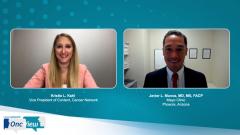
Use of Tazemetostat for R/R FL
An expert in relapsed/refractory follicular lymphoma discusses the approval of tazemetostat as a treatment and reviews the phase 2 clinical trial data.
Kristie L. Kahl: Next, I wanted to review the recent approval of tazemetostat. Can you discuss the MOA [mechanism of action] of the drug in the treatment of relapsed/refractory follicular lymphoma?
Javier L. Munoz, MD, MS, FACP: Activating mutations of EZH2, which is an epigenetic regulator, occurs in approximately 20% of patients with follicular lymphoma. High-level discussion, EZH2 is a regulator that controls the fate of cells, probably not only when it comes to gain of function mutations, but it probably also has some indirect effects as well, and that is probably why we can see responses in patients with EZH2 wild type. Now if you want to go deeper, the EZH2 gene provides instructions for making a type of enzyme called a histone methyltransferase. Histone methyltransferases modify proteins called histones, which are structural proteins that attach or bind to the DNA and give chromosomes their shape, almost like a rosary. By adding a molecule called a methyl group to the histones, a process called methylation, again, the histone methyltransferases can turn off or suppress the activity of certain genes. By turning off particular genes, this complex is involved in the process that ultimately determines the type of cell an immature cell will ultimately become, and that is why I said that it’s involved in cell fate determination. Why is this relevant? Tazemetostat is the first in class, it’s a first-in-class EZH2 inhibitor, already FDA approved, published in Lancet Oncology, so this is a testament to the work of the investigators involved. It’s an oral therapy with activity in patients both with EZH2 mutations and wild type. Hence it has been a welcome addition to our armamentarium when it comes to follicular lymphoma.
Kristie L. Kahl: There was a phase 2 trial recently published in Lancet Oncology. Can you review the study design, safety, and results?
Javier L. Munoz, MD, MS, FACP: This study was an open-label, single-arm, phase 2 trial performed at multiple hospitals in different countries, including the US. Eligible patients were adults who had confirmed follicular lymphoma, either grade 1, 2, 3a, or 3b. They had relapsed or refractory disease after 2 or more systemic lines of therapy. They needed to have good performance status, zero to 2, and they needed to have enough tissue for central testing when it comes to EZH2 mutation status. Subsequently, patients were categorized by EZH2 status. You could be EZH2 mutated or wild type. All patients received 800 mg of tazemetostat orally twice per day in a continuous fashion over 28 days, so each cycle was 28 days. The primary end point for this particular study was objective response rate.
Transcript edited for clarity.
Newsletter
Stay up to date on recent advances in the multidisciplinary approach to cancer.

















































































